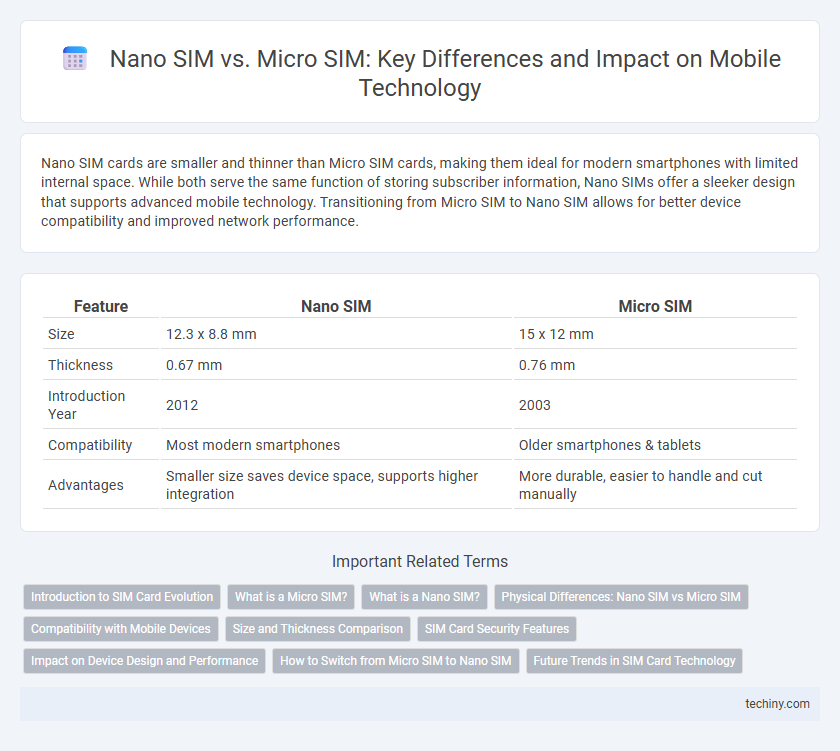Nano SIM cards are smaller and thinner than Micro SIM cards, making them ideal for modern smartphones with limited internal space. While both serve the same function of storing subscriber information, Nano SIMs offer a sleeker design that supports advanced mobile technology. Transitioning from Micro SIM to Nano SIM allows for better device compatibility and improved network performance.
Table of Comparison
| Feature | Nano SIM | Micro SIM |
|---|---|---|
| Size | 12.3 x 8.8 mm | 15 x 12 mm |
| Thickness | 0.67 mm | 0.76 mm |
| Introduction Year | 2012 | 2003 |
| Compatibility | Most modern smartphones | Older smartphones & tablets |
| Advantages | Smaller size saves device space, supports higher integration | More durable, easier to handle and cut manually |
Introduction to SIM Card Evolution
Nano SIM represents the latest advancement in SIM card technology, significantly smaller than the Micro SIM, measuring just 12.3 x 8.8 mm compared to Micro SIM's 15 x 12 mm. This evolution from standard SIM to Micro SIM and now Nano SIM reflects the industry's shift towards more compact and efficient designs, enabling slimmer and more lightweight mobile devices. Enhanced space-saving allows manufacturers to allocate room for larger batteries and advanced hardware components in smartphones.
What is a Micro SIM?
A Micro SIM is a smaller version of the traditional SIM card, measuring 15mm by 12mm, used to connect mobile devices to a cellular network. It offers the same functionality as a standard SIM but fits into slimmer, more compact smartphones and tablets. Micro SIM cards became widely adopted during the transition from older SIM formats, balancing size reduction with compatibility.
What is a Nano SIM?
A Nano SIM is the smallest SIM card size used in mobile devices, measuring 12.3 x 8.8 mm, which allows for increased internal space for other components. It maintains the same functionality as Micro SIM and Mini SIM cards, enabling network connectivity and identity verification on GSM networks. This SIM type is widely adopted in modern smartphones, including iPhones from the iPhone 5 onwards and various Android models, due to its compact design and efficiency.
Physical Differences: Nano SIM vs Micro SIM
Nano SIM cards measure 12.3 x 8.8 mm, significantly smaller than Micro SIM cards, which are 15 x 12 mm, offering a thinner and more compact design ideal for modern smartphones. The reduced size of Nano SIMs allows for more internal space within devices, accommodating larger batteries and advanced components. Despite size differences, both SIM types maintain standard contact layouts, ensuring seamless connectivity and compatibility with respective SIM card slots.
Compatibility with Mobile Devices
Nano SIM cards offer greater compatibility with the latest mobile devices due to their smaller size and modern design, fitting seamlessly into smartphones, tablets, and other compact gadgets. Micro SIM cards, while still compatible with many devices, are predominantly used in slightly older models that require a larger SIM card slot. Users must check device specifications to ensure proper SIM card compatibility and avoid connectivity issues in mobile technology.
Size and Thickness Comparison
Nano SIM measures 12.3 x 8.8 mm and is thinner at 0.67 mm, while Micro SIM is larger at 15 x 12 mm with a thickness of 0.76 mm. The reduced size and thickness of Nano SIM allow for more space in mobile devices, enabling slimmer designs and larger batteries. Nano SIM's compact dimensions enhance compatibility with modern smartphones, compared to the bulkier Micro SIM format.
SIM Card Security Features
Nano SIM cards offer enhanced security features compared to Micro SIMs due to their updated encryption protocols and improved resistance to physical tampering. Both types support standard SIM card security measures like PIN protection and network authentication, but Nano SIMs often incorporate advanced hardware-level security elements for better protection against cloning and fraud. Mobile devices using Nano SIMs benefit from these improvements, providing stronger safeguards for sensitive user data and secure mobile transactions.
Impact on Device Design and Performance
Nano SIM, being smaller than Micro SIM, significantly reduces the internal space required for SIM card slots in mobile devices, allowing manufacturers to design slimmer and more compact smartphones. The reduced size also contributes to improved device thermal management and battery placement options, enhancing overall device performance and efficiency. Micro SIM, while larger, offers slightly easier handling but limits advanced design flexibility and space optimization compared to Nano SIM.
How to Switch from Micro SIM to Nano SIM
Switching from a Micro SIM to a Nano SIM requires obtaining a Nano SIM card from your mobile carrier or using a SIM card cutter to trim the Micro SIM to the smaller Nano SIM size while preserving the chip. Ensure the Nano SIM is compatible with your device model, such as iPhone 12 or Samsung Galaxy S21, which exclusively use Nano SIMs for optimal connectivity. Carefully insert the Nano SIM into the SIM tray to avoid damage and reactivate your mobile number through your carrier's network settings or customer service.
Future Trends in SIM Card Technology
Nano SIM cards dominate current smartphone designs due to their minimal size of 12.3 x 8.8 mm, enabling slimmer device profiles and enhanced internal space for advanced components. Emerging trends highlight the shift towards eSIM technology, which offers embedded programmability and eliminates the need for physical SIM cards, promoting seamless carrier switching and increased device security. Future developments are expected to focus on integrated SIM solutions within 5G and IoT devices, enhancing connectivity while reducing physical constraints.
Nano SIM vs Micro SIM Infographic

 techiny.com
techiny.com